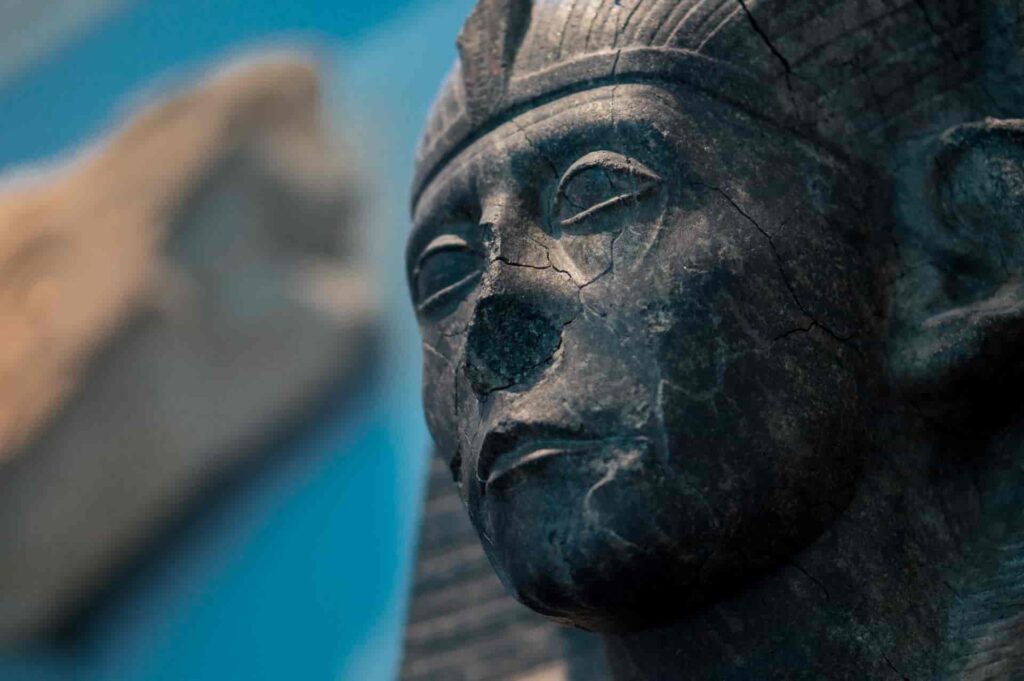The reign of Senusret III (circa 1878-1843) marks the zenith of the Middle Kingdom. He is the fifth king of the Twelfth Dynasty, the son of Senusret II and Queen Khenemetneferhedjet I.
His reign was particularly distinguished by four military campaigns extending to the second cataract in Nubia. This effort ensured the steady supply of luxury products from the rest of Africa and gold from the eastern desert, facilitated by the construction of a series of seven fortresses.
Senusret III inherited an extended period of peace, which he interrupted with his four campaigns to the south. His father had initiated the development of the Fayoum oasis through significant urbanization and irrigation projects. Egyptian influence in Byblos, the ancient and amicable city of Phoenicia, was stronger than ever.
Genealogy
Senusret III’s parents are his predecessor, King Senusret II, and Queen Khenemetneferhedjet I.
It was during the reign of Senusret III that the title of “Great Royal Wife” first appeared. This distinction was bestowed upon Queen Meretseger, also known as “She Who Loves Silence”. She would also become the first queen whose name was inscribed within a cartouche.
Senusret III limited his seraglio to four wives. His spouses were Neferthenut, Khnemetneferhedjet II, Itakayt, and Meretseger. He fathered six known children: a son named the future Amenemhat III, and five daughters named Khnemet, Menet, Mereret, Senetsenebtysy, and Sithathor.
The King: The Warrior
Senusret III defined his era through four triumphant wars in Nubia. He also oversaw the construction of one of Egypt’s most impressive southern borders.
Traces of this border can be dated back to around 2600 BC. The encounters with the pharaonic regime, characterized by violence, didn’t originate solely during the Middle Kingdom. King Sneferu (c. 2600) had previously conducted raids into Nubia, capturing 7,000 prisoners and 200,000 head of cattle.
The initial war against the Nubians was led by Senusret I, who had advanced his conquests as far as the Second Cataract region.
Upon his ascension, Senusret III’s father, Senusret II, had initiated preliminary preparations as the Nubian people occupied the aforementioned area. However, it was with the onset of the first campaign under Sesostris III that a deliberate offensive strategy unfolded, entailing the reconstruction and construction of fortresses.
Indeed, Senusret III went on to augment the existing seven fortresses established by his predecessors. This marked the creation of the world’s first extensive network of defensive military architecture.
After extensive preparations, a channel was excavated alongside the first cataract, as evidenced by two commemorative stelae on the cliffs of Sehel Island. This facilitated the passage of Senusret III’s fleet.
The army descended upon Semna, extending their reach well beyond the second cataract. This endeavor led to the establishment of seven fortresses, five of which were positioned on rocky outcrops, featuring mud-brick walls reaching heights of up to twenty feet. Senusret III proceeded to lead three additional campaigns until the conclusion of his reign.
Senusret III: The Administrator
Following the annexation of territory that expanded Egypt’s landmass by a third, the ruler assumed responsibility for its administrative reorganization, cultivating a “middle class” of minor officials. These individuals were stationed in newly established royal cities.
The influential families of nomarchs, who were provincial governors, had previously aligned themselves with royal authority. Their decline wasn’t a result of a purge.
The oversight of Upper and Middle Egypt’s territory increasingly shifted from traditional nomarchs—local leaders of a “nome”—to governors situated in urban centers.
The antiquated administrative framework that justified the roles of these local rulers became obsolete, replaced by a more refined division centered around the city and its environs, featuring new administrative representatives.
However, around 1800, during the reign of Senusret III’s son, Amenemhat III, major cities in Upper Egypt such as Edfu and El Kab still remained under the control of prominent families. Conversely, due to military campaigns in Nubia, the king had acquired an expansive territory located between the two cataracts.
The new southern district, on the other hand, was under direct management by the vizier’s office, overseeing the “royal domain.” This same body supervised the stationed soldiers along the Nubian border. The administration of provinces varied based on specific locations and circumstances.










